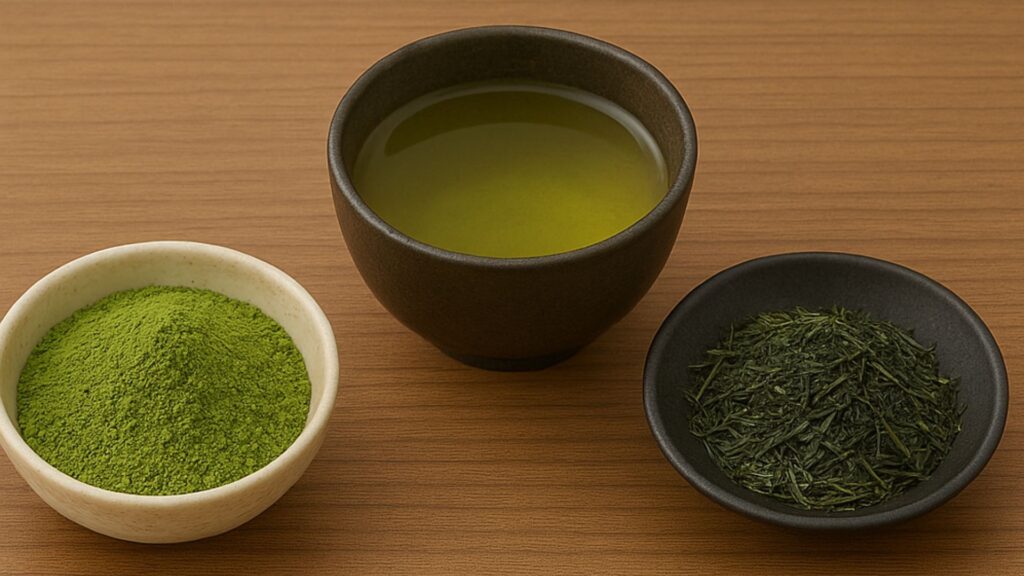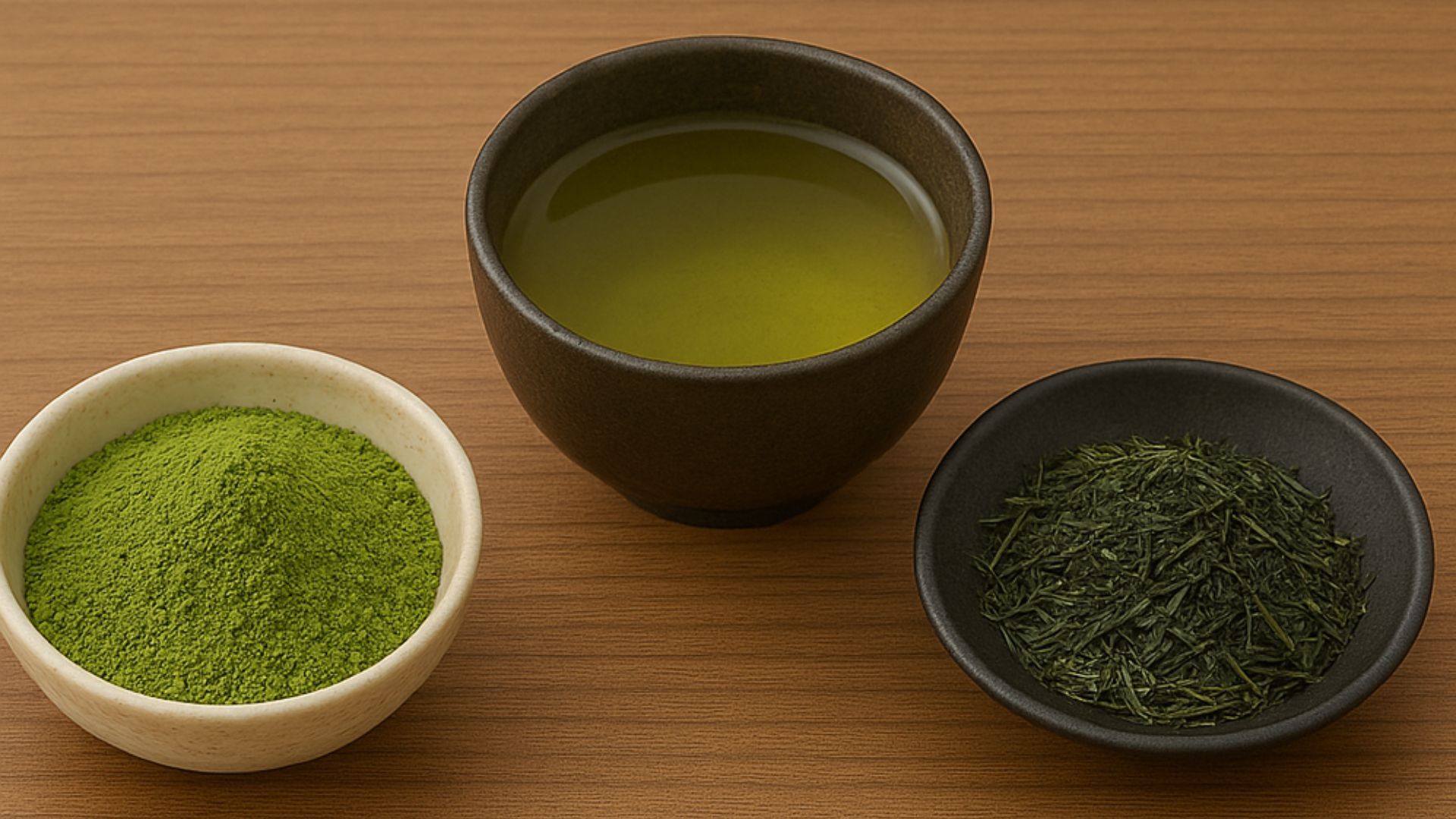
Have you ever thought, “Matcha seems so luxurious,” “I’ve heard Gyokuro is incredibly sweet…” or “I drink Sencha all the time, but what sets it apart from the others?” The world of Japanese tea is full of deep and unique charms. In fact, differences in cultivation and production methods have a significant impact on taste and nutrition.
In this article, we’ll clearly explain the distinctions between Gyokuro, Sencha, and Matcha, incorporating a scientific perspective along the way. By the end, you’ll find hints to help you decide, “Which tea should I choose?” So, please read on until the very end.
1. Cultivation Methods Decide It All!? How Three Teas Are Made
Surprisingly, Sencha, Gyokuro, and Matcha all come from the same tea plant—Camellia sinensis.
What makes them different lies in two key factors:
- How much sunlight the tea leaves are exposed to during cultivation
- How the leaves are processed after harvesting
Just these two elements can dramatically change the flavor, aroma, and even the nutritional content of the tea.
Sencha: A refreshing tea bathed in abundant sunshine.
Sencha is the most common type of Japanese green tea, made by steaming, rolling, and drying young tea leaves that have been fully exposed to sunlight. It’s known for its bright green color and a well-balanced flavor that combines refreshing astringency with a touch of natural sweetness.
Gyokuro: A luxuriously mellow tea carefully grown in the shade.
Gyokuro is grown using a special method called “covered cultivation,” in which the tea plants are shaded from sunlight for about three weeks before harvest. This process enhances the tea’s sweetness and umami, while greatly reducing its astringency. It also produces a distinctive aroma known as ooika, often compared to the scent of nori (seaweed). Gyokuro is cherished as a luxurious and refined tea.
Matcha: A rich green tea experience that lets you drink the whole leaf.
Like Gyokuro, Matcha is made from tea leaves grown in the shade. However, after harvesting, the leaves are steamed, dried, and then ground into a fine powder using a traditional stone mill. Unlike other green teas, Matcha is mixed directly with hot water, allowing you to consume the entire tea leaf. This makes it uniquely rich in both flavor and nutrients.
2. Is the Difference in Taste Determined by the Amount of Light?
「“Why does shading make tea taste sweeter?”
It all comes down to how sunlight affects the chemical composition of the leaves.
The key umami component in tea—theanine—is transformed into catechins (which create astringency) when the leaves are exposed to sunlight.
In other words:
- Sencha, grown in full sunlight → higher catechin levels → more pronounced astringency
- Gyokuro and Matcha, grown in shade → rich in theanine → sweet and mellow flavor
This fundamental difference is what creates the distinct flavor profiles of each tea.
3. Nutritional Differences – Actually a Trade-Off
Let’s take a moment to talk about the health benefits of green tea.
Here are three of the main nutrients found in green tea:
| Component | Role | Tea with High Content |
|---|---|---|
| Catechins | Astringency; known for antioxidant effects and fat-burning properties | Sencha |
| Theanine | Sweetness and umami; promotes relaxation | Gyokuro, Matcha |
| Caffeine | Bitterness; has stimulating and alertness-enhancing effects | Matcha, Gyokuro (especially first flush leaves) |
Now, here’s the key point.
Shading the tea plants does indeed increase umami—but at the same time, it reduces catechins, which are widely known for their health benefits.
In other words, it’s a classic trade-off between umami and catechins.
When you’re in the mood for something smooth and naturally sweet, Gyokuro or Matcha is the perfect choice. But…
When you’re mindful of your health and want to harness the full benefits of tea—including its astringency
—Sencha, grown under the full blessing of the sun, becomes a truly powerful and reliable ally.
4. Which Tea Will You Choose? – Conclusion: Choose Based on Your Mood and Purpose
There’s no single “best” among Matcha, Gyokuro, and Sencha—each has its own special role to play.
- When you want deep relaxation → Enjoy the gentle umami of Gyokuro
- When you need focus or feel like indulging → Choose Matcha for a rich, concentrated green tea experience
- For your daily health routine or a post-meal companion → Refresh yourself with the pleasant astringency of Sencha
The best approach is to choose your tea based on your mood and purpose for the day.
If you’re not sure where to start, why not begin with Sencha?
Sencha strikes the perfect balance between flavor and nutrition, making it both affordable and easy to incorporate into your daily life. Plus, it offers the added benefit of delivering a solid dose of catechins, known for their health-supporting properties.
Exactly…
It’s the perfect balance of great taste and health benefits—the best of both worlds.
If you’re someone who finds the bitterness or astringency of sencha a bit too strong, try brewing it with slightly cooler water—around 70°C (158°F). This softens the overall intensity of the tea while significantly reducing its bitterness and astringency.
By the way, do you know which region in Japan has held the top spot in the National Tea Competition’s Sencha category for 21 consecutive years since 2004?
The answer is Kagoshima Prefecture, home to some of the finest sencha in the country.
For those who wish to experience authentic Kagoshima Sencha,
please visit our dedicated page.
In Conclusion
Matcha, Gyokuro, and Sencha—each one is a proud symbol of Japan’s rich tea culture.
But by understanding the unique differences between them, you’ll discover a whole new depth to the world of tea. And maybe, just maybe, today’s cup will feel a little more special than yesterday’s.
So… which tea will you choose?


Comments